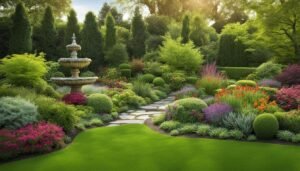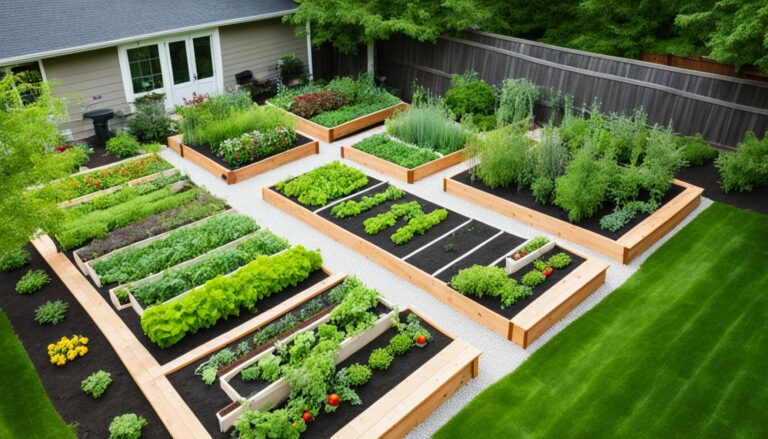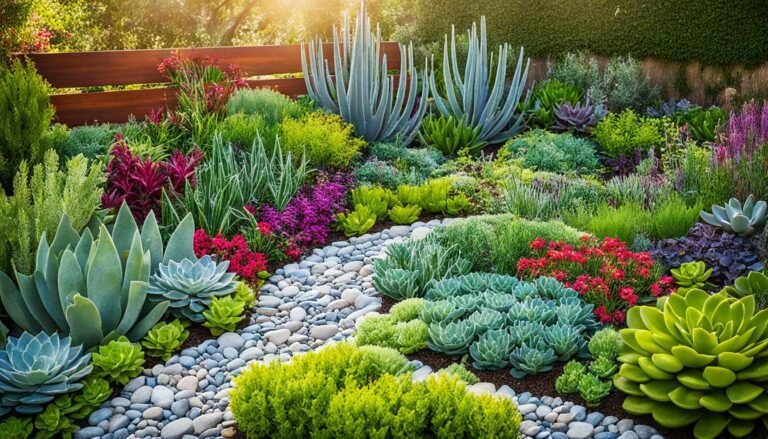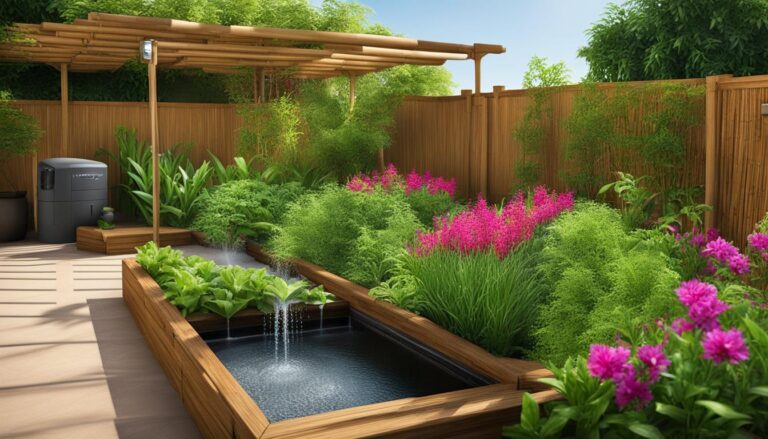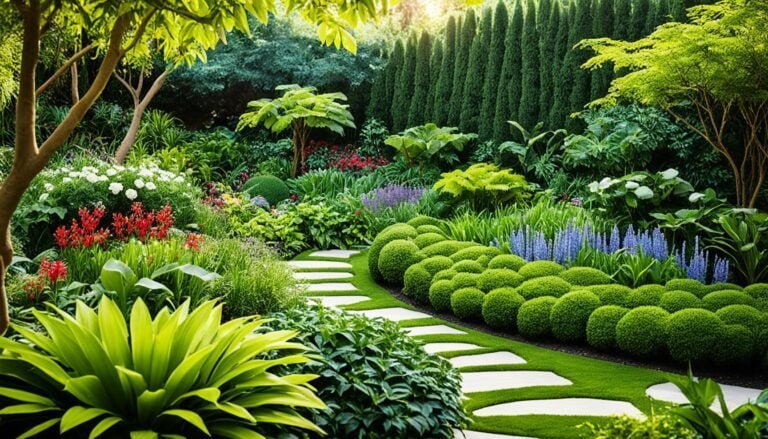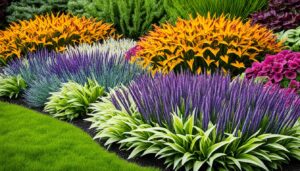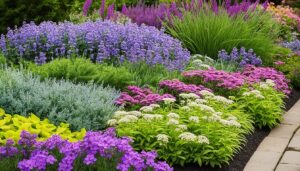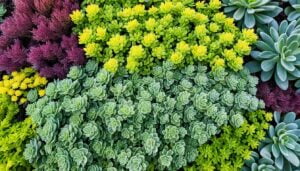Welcome to our article on garden aesthetic designs, where we delve into the art of crafting visual harmony in outdoor spaces. From harmonious landscapes to captivating garden aesthetics, we explore the elements that contribute to creating a visually appealing and balanced garden sanctuary.
Key Takeaways:
- Garden aesthetic designs involves creating visual appeal and beauty in outdoor spaces.
- Harmony and balance are key principles in achieving a visually pleasing garden aesthetic design.
- Plant selection, garden layout, colors, textures, and overall design principles contribute to harmony and balance.
- Embrace simplicity and natural materials in Zen-inspired hardscape designs.
- Incorporate water features and symbolic elements to enhance the serenity of a Zen-inspired garden.
Harmony and Balance in Garden Aesthetic Designs
In garden aesthetics, the concept of harmony and balance plays a significant role in creating visually pleasing and harmonious outdoor spaces. Achieving harmony and balance involves careful consideration of plant selection, garden layout, colors, and textures. By understanding and applying these principles, you can create a garden that is not only visually appealing but also promotes a sense of tranquility and cohesiveness.
When it comes to plant selection, choosing the right plants is essential for achieving harmony in your garden. Consider factors such as the color, texture, size, and growth habit of the plants. Select plants that complement each other and create a cohesive overall look. For example, pairing plants with contrasting foliage textures or coordinating flower colors can add visual interest and balance to your garden.
Additionally, thoughtful garden layout is crucial in creating a harmonious space. Arrange plants in a way that creates balance and symmetry. Utilize different heights and forms to add dimension and interest to your garden. Consider creating focal points and pathways that guide the eye and create a sense of flow. By carefully planning your garden layout, you can establish a harmonious and visually appealing outdoor space.
Colors and textures also play a significant role in achieving harmony and balance in garden aesthetics. Consider the color palette of your plants and envision how they will interact with each other. Complementary or analogous color schemes can create a harmonious and cohesive look. Additionally, explore the use of textures by incorporating plants with different leaf shapes and surface textures. This variation adds depth and visual interest to your garden.
By understanding and applying the principles of harmony and balance in garden aesthetics, you can create a visually pleasing and harmonious outdoor space that brings joy and tranquility to your life.
| Elements | Tips to Achieve Harmony and Balance |
|---|---|
| Plant Selection |
|
| Garden Layout |
|
| Colors and Textures |
|
Plant Selection And Care With Garden Aesthetic Designs

Proper plant selection and care are vital factors in creating and maintaining a harmonious and balanced garden aesthetic. By considering plant health, placement, and maintenance, you can ensure that your plants thrive and contribute to the overall visual appeal of your garden.
Plant selection: When choosing plants for your garden, it’s essential to consider their compatibility with the climate, soil conditions, and available sunlight. Selecting plants that are well-suited to your specific environment will promote optimal growth and health, enhancing the overall harmony of your garden.
Plant care: Caring for your plants involves providing them with the necessary resources to thrive. Proper watering techniques, regular fertilization, and appropriate sunlight exposure are key components of plant care. By addressing the specific needs of each plant, you can maintain their health and vitality, ensuring they contribute to a visually stunning garden.
Plant health: Monitoring the health of your plants is crucial in maintaining their visual appeal and overall contribution to your garden aesthetics. Regularly inspecting for pests, diseases, and signs of nutrient deficiencies allows you to take timely action to address any issues that may arise. By promoting plant health, you ensure that your garden remains vibrant and visually appealing.
Plant placement: The placement of plants in your garden plays a significant role in creating balance and harmony. Consider the lighting requirements of each plant and arrange them accordingly. Pay attention to growth habits and ensure proper spacing to avoid overcrowding. By thoughtfully placing plants, you can maintain a visually pleasing and well-balanced garden aesthetic.
Maintenance and pruning: Regular maintenance and pruning are essential tasks in achieving a visually appealing garden. By trimming back overgrown plants, shaping shrubs, and removing dead or damaged foliage, you can maintain the overall form and structure of your garden. Pruning also helps encourage healthy growth and enhances the visual appeal of your plants.
By prioritizing proper plant selection, care, and maintenance, you can create a garden that not only looks beautiful but also thrives in its environment. The holistic approach to plant selection and care contributes to the overall harmony and balance of your garden aesthetic.
| Plant Selection and Care Checklist |
|---|
| Consider plant compatibility with climate, soil, and sunlight conditions |
| Provide proper watering, fertilization, and sunlight exposure |
| Monitor plant health and address issues promptly |
| Place plants thoughtfully, considering lighting and growth habits |
| Maintain regular maintenance and pruning routine |
Embracing Simplicity in Zen-inspired Hardscape With Garden Aesthetic Designs

Zen-inspired hardscape designs offer a serene and minimalist approach to outdoor aesthetics. By embracing simplicity, these designs create harmonious spaces that invite tranquility and contemplation. Let’s explore the key elements that contribute to the beauty and serenity of Zen-inspired hardscapes.
Minimalist Structures
At the heart of Zen-inspired hardscapes are minimalist structures. These structures feature clean lines and a focused functionality that serves a purpose while maintaining a streamlined look. By eliminating unnecessary ornamentation, the focus is directed towards the natural surroundings, allowing the inherent beauty of the landscape to shine through.
Natural Materials
Another essential aspect of Zen-inspired hardscapes is the use of natural materials. Weathered stone and wood are often incorporated into the design, bringing a sense of organic elegance and grounding the space in its natural environment. These materials not only enhance the aesthetic appeal but also create a harmonious connection between the hardscape and the surrounding landscape.
Meditative Pathways
The inclusion of meditative pathways is a hallmark of Zen-inspired hardscapes. These pathways, with their curved design and stepping stones, encourage a slow and contemplative pace. As you navigate these pathways, the rhythm of your steps merges with the natural elements around you, creating a meditative experience and promoting a sense of calm and balance.
With their focus on simplicity, minimalist structures, natural materials, and meditative pathways, Zen-inspired hardscapes offer a unique approach to outdoor design. By embracing these elements, you can transform your outdoor space into a peaceful oasis that invites relaxation and harmonizes with nature.
Water Features for Serenity in Zen-inspired Hardscapes
In Zen-inspired hardscapes, water features are essential elements that contribute to the overall serenity of the space. Incorporating reflective ponds and subtle cascades creates a tranquil and peaceful ambiance, enhancing the Zen experience. These water features not only add visual appeal but also create a sensory dimension in the hardscape design, offering a soothing and calming environment.
Reflective Ponds: Mirroring Tranquility
Reflective ponds are a hallmark of Zen-inspired hardscapes. These serene and still bodies of water mirror the tranquility of nature, creating a sense of peace and harmony within the garden. The reflective surface of the pond not only adds a visual element but also nurtures a feeling of calmness, allowing individuals to connect with their surroundings on a deeper level.
Subtle Cascades: The Sound of Serenity
To further enhance the Zen experience, subtle cascades or bamboo spouts can be incorporated into the hardscape design. The gentle flow of water creates a soothing and meditative atmosphere, evoking a sense of serenity and tranquility. The subtle sound of cascading water adds a sensory dimension to the hardscape, providing a calming soundtrack for relaxation and contemplation.
Water features have the power to transform Zen-inspired hardscapes into serene havens, where individuals can find peace and tranquility amidst the daily chaos. By incorporating reflective ponds and subtle cascades, a Zen-like experience is created, allowing individuals to immerse themselves in the beauty and serenity of their outdoor space.
| Benefits of Water Features in Zen-inspired Hardscapes |
|---|
| 1. Creates a tranquil and serene atmosphere. |
| 2. Enhances the overall Zen experience. |
| 3. Adds visual appeal and aesthetics to the hardscape design. |
| 4. Provides a sensory dimension with the sound of flowing water. |
Symbolic Elements in Zen-inspired Hardscapes
Symbolic elements are integral to creating Zen-inspired hardscapes that exude serenity and tranquility. By carefully incorporating representative stones, raked gravel patterns, and delicate bridges, you can add a deeper layer of meaning and aesthetic appeal to your garden.
Representative Stones: Focal Points of Permanence and Stability
The strategic arrangement of representative stones is a key aspect of Zen-inspired hardscape design. These stones, carefully selected for their shape and texture, are positioned to symbolize natural formations such as mountains, islands, or waterfalls. Serving as focal points in the garden, they evoke a sense of permanence and stability, creating a visual connection to the natural world.
Raked Gravel Patterns: Artistic Flow and Meditation
Raked gravel patterns are another iconic feature of Zen-inspired hardscapes. The intricate designs, meticulously created using a rake, mimic the flow of water or ripples in a pond. These patterns not only add a visual appeal to the hardscape but also possess a deeper significance. They symbolize the fluidity of nature and evoke a sense of calm and tranquility. Raking the gravel can also be seen as a form of meditation, allowing the gardener to engage in a mindful and contemplative practice.
Delicate Bridges: Invitations to Contemplation
Delicate bridges made from natural materials, such as wood or stone, are a common feature in Zen-inspired hardscapes. These bridges act as transitions, connecting different areas of the garden and inviting contemplation. Crossing these bridges encourages a slower pace, allowing individuals to fully immerse themselves in the serene environment. The delicacy of the bridge design reflects the essence of minimalism and simplicity, harmonizing with the overall aesthetic of the hardscape.
Immerse yourself in the beauty of symbolic rock arrangements, representative stones, raked gravel patterns, and delicate bridges. These elements carry a profound meaning and contribute to the overall serene atmosphere of Zen-inspired hardscapes.
| Symbolic Elements | Features |
|---|---|
| Representative Stones | Symbolize natural formations |
| Raked Gravel Patterns | Mimic flow of water or ripples in a pond |
| Delicate Bridges | Connect different areas and invite contemplation |
Creating Inviting Outdoor Gathering Spaces
When designing your garden, it’s important to create spaces that are not only visually appealing but also welcoming and functional. By considering design elegance and incorporating practical elements, you can create outdoor gathering spaces that invite relaxation, connection, and enjoyment. Let’s explore some key factors to consider:
Design Elegance
Aesthetics play a significant role in setting the tone for your outdoor gathering spaces. Strive for design elegance by incorporating elements that complement your garden’s overall style and harmonize with natural surroundings. Thoughtful touches like pergolas, trellises, or decorative screens can bring a touch of sophistication while creating a sense of privacy and enclosure.
Functional Zones
Functional zones help define different areas of your garden and create a sense of purpose. Consider the activities you wish to accommodate in your outdoor gathering spaces. Whether it’s a dedicated dining area, a cozy reading nook, or a space for entertaining guests, having designated zones helps establish order and maximizes the functionality of your garden.
Comfortable Seating
A comfortable seating area is a must for creating inviting gathering spaces. Choose seating options that are both aesthetically pleasing and comfortable, ensuring your guests feel relaxed and at ease. From lounge chairs to outdoor sofas and hammocks, select furniture that complements your garden’s style while providing a cozy and inviting place to sit and unwind.
Fire Pit
A fire pit adds warmth, ambiance, and extended usability to your outdoor gathering spaces. Whether you opt for a traditional fire pit or a modern gas-powered design, this feature creates a focal point and encourages gathering and conversation, even on chilly evenings. Surround the fire pit with comfortable seating to create a cozy and inviting atmosphere.
Inviting Spaces
Above all, the goal of creating outdoor gathering spaces is to make them irresistibly inviting. Pay attention to small details like lighting, soft furnishings, and greenery. Incorporate elements that create a welcoming atmosphere and encourage your guests to linger and enjoy the beauty and tranquility of your garden.
Remember, design elegance, functional zones, comfortable seating, and the addition of a fire pit are key factors in creating inviting outdoor gathering spaces. Combine these elements thoughtfully, and you’ll have a garden that becomes the perfect retreat for both relaxation and socialization, an oasis of comfort and beauty in your own backyard.
Conclusion
Garden aesthetic designs, Crafting a visually harmonious garden is a transformative experience that goes beyond mere aesthetics. It involves carefully considering elements such as plant selection, garden layout, colors, and textures to create a space that brings together nature and style. By incorporating sustainable practices and functional gathering spaces, you can elevate your outdoor space into a breathtaking garden oasis.
Harmony and balance are the guiding principles in achieving a visually appealing garden. By carefully selecting plants that complement each other in terms of color, texture, and growth habit, you can create a cohesive and balanced design. The thoughtful arrangement of plants and the use of harmonizing colors and textures further enhance the visual appeal and create a sense of tranquility in your garden.
But a harmonious outdoor space is not just about aesthetics. It also embraces sustainable practices that promote environmental responsibility. By adopting practices such as water conservation, organic gardening, and using eco-friendly materials, you contribute to the well-being of the ecosystem and create a garden that is in harmony with the natural world.
Lastly, creating functional gathering spaces allows you to fully enjoy your garden oasis. By incorporating comfortable seating, defining cozy areas, and adding features like fire pits or outdoor fireplaces, you create inviting spaces that beckon you to relax and connect with nature. These gathering spaces add depth and functionality to your garden, turning it into a haven where you can unwind and find peace.
FAQ
What is garden aesthetic designs?
Garden aesthetic designs refers to the visual appeal and beauty of a garden. It encompasses elements such as plant selection, garden layout, colors, textures, and overall design principles.
How can harmony and balance be achieved in garden aesthetics?
Harmony and balance can be achieved in garden aesthetics through careful consideration of plant selection, including factors such as color, texture, size, and growth habit. Additionally, arranging plants in a balanced layout and using harmonizing colors and textures contribute to achieving visual harmony and balance.
Why is plant selection and care important in garden aesthetics?
Proper plant selection and care are crucial in achieving harmony and balance in garden aesthetics. This involves considering factors such as plant health, placement, and maintenance to ensure their vitality and contribution to the overall garden aesthetics.
What are some elements of Zen-inspired hardscape designs?
Zen-inspired hardscape designs embrace simplicity and use minimalist structures with clean lines and functional elements. Natural materials like weathered stone and wood are often incorporated, and meditative pathways with curved designs and stepping stones add to the tranquility and balance of the space.
How do water features contribute to the serenity of Zen-inspired hardscapes?
Water features such as reflective ponds and subtle cascades enhance the overall serenity of Zen-inspired hardscapes. Reflective ponds mirror the tranquility of nature, while subtle cascades or bamboo spouts add the soothing sound of flowing water, creating a sensory dimension in the hardscape design.
What are some symbolic elements in Zen-inspired hardscapes?
Symbolic elements in Zen-inspired hardscapes include representative stones strategically arranged to symbolize natural formations. Raked gravel patterns create intricate designs resembling the flow of water, and delicate bridges made from natural materials like wood or stone serve as transitions between different areas in the garden.
How can inviting outdoor gathering spaces be created?
Inviting outdoor gathering spaces can be created by considering design elegance and functional zones. This involves defining cozy seating areas, incorporating elements like pergolas or trellises, and adding features such as fire pits or outdoor fireplaces to extend the usability of the space into colder evenings.
How can a visually harmonious garden be created?
To create a visually harmonious garden, elements such as plant selection, garden layout, colors and textures should be carefully considered. Sustainable practices and the incorporation of functional gathering spaces also contribute to achieving a garden oasis that blends style with nature.

